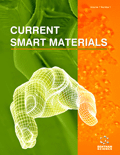[1]
Omidian, H.; Rocca, J.G.; Park, K. Advances in superporous hydrogels. J. Control. Release, 2005, 102, 3-12.
[2]
Li, G.; Zhao, Y.; Zhang, L.; Gao, M.; Kong, Y.; Yang, Y. Preparation of graphene oxide/polyacrylamide composite hydrogel and its effect on Schwann cells attachment and proliferation. Colloids Surf. B Biointerfaces, 2016, 143, 547-556.
[3]
Li, M.Y.; Guo, Y.; Wei, Y.; Mac Diarmid, A.G.; Lelkes, P.I. Electrospinning polyaniline-contained gelatin nanofibers for tissue engineering applications. Biomaterials, 2006, 27(13), 2705-2715.
[4]
Siddhanta, S.K.; Gangopadhyay, R. Conducting polymer gel: Formation of a novel semi-IPN from polyaniline and crosslinked poly(2-acrylamido-2-methyl propanesulphonicacid). Polym. J., 2005, 46, 2993-3000.
[5]
Small, C.J.; Too, C.O.; Wallace, G.G. Responsive conducting polymer-hydrogel composites. Polym. Gels Netw., 1997, 5, 251-265.
[6]
Wada, H.; Nohara, S.; Iwakura, C. Electrochemical characteristics of electric double layer capacitor using sulfonated polypropylene separator impregnated with polymer hydrogel electrolyte. Electrochim. Acta, 2004, 49, 4871-4875.
[7]
Wu, J.H.; Wei, Y.L.; Lin, J.M.; Lin, S.B. Study on starch-graft-acrylamide/mineral powder superabsorbent composite. Polymer, 2003, 44, 6513-6520.
[8]
Ito, K.; Chuang, J.; Carmen, A.L.; Watanabe, T.; Ando, N.A.; Yu, G. Multiple point adsorption in a heteropolymer gel and the Tanaka approach to imprinting: Experiment and theory. Prog. Polym. Sci., 2003, 28, 1489-1515.
[9]
Tang, Q.; Wu, J.; Sun, H.; Fan, S.; Hu, D.; Lin, J. Superabsorbent conducting hydrogel from poly(acrylamide-aniline) with thermo-sensitivity and release properties. Carbohydr. Polym., 2008, 73, 473-481.
[10]
Tang, Q.; Wu, J.; Lin, J. A multifunctional hydrogel with high conductivity, pH-responsive, thermo-responsive and release properties from polyacrylate/polyaniline hybrid. Carbohydr. Polym., 2008, 73, 315-321.
[11]
Lin, J.; Tang, Q.; Wu, J. The synthesis and electrical conductivity of a polyacrylamide/Cu conducting hydrogel. React. Funct. Polym., 2007, 67, 489-494.
[12]
Lin, J.; Tang, Q.; Wu, J.; Hao, S. The synthesis and electrical conductivity of a polyacrylate/graphite hydrogel. React. Funct. Polym., 2007, 67, 275-281.
[13]
Ali, T.O. The corrosion performance of polyaniline film modified on nickel plated copper in aqueous p-toluenesulfonic acid solution. Surf. Coat. Tech., 2006, 200(12-13), 3918-3925.
[14]
Lin, J.; Tang, Q.; Wu, J.; Sun, H.; Fan, S.; Hu, D. Two-step synthesis and conductivity of polyacrylamide/Cu conducting hydrogel. Polym. Compos., 2009, 30, 1132-1137.
[15]
Tang, Q.; Sun, X.; Wu, J.; Li, Q.; Lin, J. Design and electrical conductivity of poly(acrylic acid-g-gelatin)/graphite conducting gel. Polym. Eng. Sci., 2009, 49, 1871-1878.
[16]
Chauhan, N.P.S.; Jangid, N.K.; Punjabi, P.B. Synthesis and characterization of conducting polyaniline via catalytic oxidative polymerization. Int. J. Polym. Mater. Polym. Biomater., 2013, 62, 550-555.
[17]
Virji, S.H.; Weiller, B.H.; Huang, J.; Blair, R.; Shepherd, H.; Faltens, T. Construction of a polyaniline nanofibre gas sensor. J. Chem. Educ., 2008, 85, 1102-1104.
[18]
Zhang, L.; Wan, M.; Wei, Y. Nanoscale polyaniline fibers prepared by ferric chloride as an oxidant. Macromol. Rapid Commun., 2006, 27, 366-371.
[19]
Sairam, M.; Nataraj, S.K.; Aminabhavi, T.M.; Roy, S.; Madhusoodana, C.D. Polyaniline membranes for separation and purification of gases, liquids, and electrolyte solutions. Separ. Purif. Rev., 2006, 35, 249-283.
[20]
Malhotra, B.D.; Ghosh, S.; Chandra, R. Polyaniline/polymeric acid composite, a novel conducting rubber. J. Appl. Polym. Sci., 1990, 40, 1049-1052.
[21]
Tiwari, A.; Sharma, Y.; Hattori, S.; Terada, D.; Sharma, A.K.; Turner, A.P.F.; Kobayashi, H. Influence of poly(n-isopropylacrylamide)-CNT-polyaniline three-dimensional electrospun microfabric scaffolds on cell growth and viability. Biopolymers, 2013, 99, 334-341.
[22]
Wu, J.; Wei, Y.; Lin, J.; Lin, S. Study on starch-graft-acrylamide/mineral powder superabsorbent composite. Polymer, 2003, 44, 6513-6520.
[23]
Lu, S.; Duan, M.; Lin, S. Synthesis of superabsorbent starch-graft-poly(potassium acrylate-co-acrylamide) and its properties. J. Appl. Polym. Sci., 2003, 88, 1536-1542.
[24]
Li, W.; Zhao, H.; Teasdale, P.R.; John, R. Preparation and characterization of poly(2-acrylamidoglycolic acid-co-acrylamide) hydrogel for selective binding of Cu2+ and application to diffuse gradients in thin films measurements. Polymer, 2002, 43, 4803-4809.
[25]
Patil, R.C.; Patil, S.F.; Mulla, I.S.; Vijayamohanan, K. Effect of protonation media on chemically and electrochemically synthesized polyaniline. Polym. Int., 2000, 49, 189-196.
[26]
Josefowicz, M.E.; Epstein, A.J.; Tang, X. Protonic acid doping of two classes of the emeraldine form of polyaniline. Synth. Met., 1992, 46, 337-340.
[27]
Mahdavinia, G.R.; Pourjavadi, A.; Hosseinzadeh, H. Modified chitosan 4. Superabsorbent hydrogels from poly(acrylic acid-co-acrylamide) grafted chitosan with salt- and pH-responsiveness properties. Eur. Polym. J., 2004, 40, 1399-1407.
[28]
Zhao, Y.; Su, H.; Fang, L.; Tan, T. Superabsorbent hydrogels from poly(aspartic acid) with salt-, temperature- and pH-responsiveness properties. Polymer, 2005, 46, 5368-5367.
[29]
Prabhakar, R.; Kumar, D. Influence of dopant ions on the properties of conducting polyacrylamide/polyaniline hydrogels. Poly. Plast. Technol., 2016, 55, 46-53.
[30]
Tzou, K.; Gregory, R.V. A method to prepare soluble polyaniline salt solution in situ doping of PANI base with organic dopants in polar solvents. Synth. Met., 1993, 53, 365-377.
[31]
Ibrahim, K.A. Synthesis and characterization of polyaniline and poly(aniline-co-nitroaniline) using vibrational spectroscopy. Arab. J. Chem., 2017, 10, 2668-2674.
[32]
Zang, H.; Lu, J.; Wang, X.; Li, J.; Wang, F. From amorphous to crystalline: Practical way to improve electrical conductivity of waterborne conducting polyaniline. Polymer, 2011, 52, 3059-3064.
[33]
Han, M.; Chu, Y.; Han, D.; Liu, Y.J. Fabrication and characterizations of oligopyrrole doped with dodecylbenzenesulfonic acid in reverse microemulsion. Colloid Interf. Sci., 2006, 296, 110-117.
[34]
Sharma, K.; Kaith, B.S.; Kumar, V.; Kalia, S.; Som, S.; Swart, H.C. Gum ghatti based novel electrically conductive biomaterials: A study of conductivity and surface morphology. Express Polym. Lett., 2014, 8, 267-281.
[35]
Tiwari, A.; Singh, V. Microwave-induced synthesis of electrical conducting gum acacia-graft-polyaniline. Carbohydr. Polym., 2008, 74, 427-434.
[36]
Wu, J.; Lin, J.; Zhou, M.; Wei, C. Synthesis and properties of starch-graft-polyacrylamide/clay superabsorbent composite. Macromol. Rapid Commun., 2000, 21, 1032-1034.
[37]
Siddhanta, S.K.; Gangopadhyay, R. Conducting polymer gel: Formation of a novel semi-IPN from polyaniline and crosslinked poly(2-acrylamido-2-methyl propanesulphonicacid). Polymer, 2005, 46, 2993-3000.
[38]
Bajpai, A.K.; Bajpai, J.; Soni, S.N. Preparation and characterization of electrically conductive composites of poly(vinyl alcohol)-g-poly(acrylic acid) hydrogels impregnated with polyaniline (PANI). Express Polym. Lett., 2008, 2, 26-39.
 21
21 5
5





